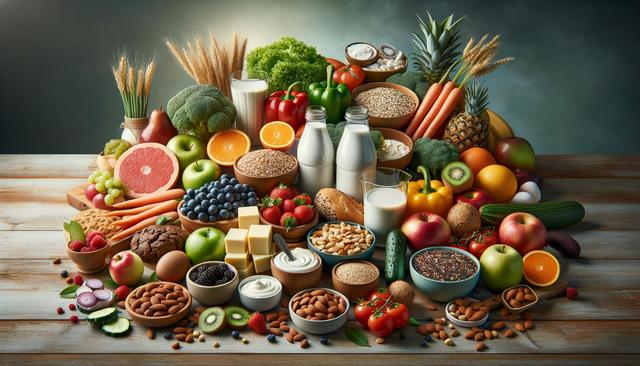
Foods That May Support Weight Loss Naturally
Leafy Greens and Their Nutritional Impact
Leafy greens such as spinach, kale, and Swiss chard are low in calories and high in fiber, making them excellent additions to meals for those looking to manage their weight. These vegetables are packed with essential nutrients like iron, calcium, and vitamins A, C, and K. The fiber content helps you feel full longer, reducing the likelihood of overeating. Additionally, leafy greens have a high water content, which contributes to satiety and hydration. Incorporating them into daily meals can be as simple as adding them to smoothies, salads, or stir-fries.
Some benefits of leafy greens include:
- Low calorie density
- High in fiber and water
- Rich in antioxidants
Regular consumption of these vegetables may support overall metabolic health and improve digestion, both of which are important for weight loss and maintenance. They also pair well with lean proteins and whole grains, creating balanced meals that fuel the body and keep hunger at bay.
Lean Proteins to Boost Satiety
Protein plays a key role in weight management by promoting feelings of fullness and supporting muscle maintenance, especially during periods of caloric reduction. Choosing lean protein sources can help limit excess saturated fat while still delivering the amino acids your body needs. Some common options include skinless poultry, legumes, eggs, and tofu. These foods can be included in a variety of recipes, from hearty soups to simple stir-fried dishes.
Benefits of lean protein for weight loss include:
- Increased satiety and reduced hunger
- Support for muscle mass during fat loss
- Thermic effect of food, which slightly increases calorie burn
Including a source of lean protein in each meal can make it easier to stick to a calorie-conscious eating plan without feeling deprived. It also helps regulate blood sugar levels, which can reduce cravings and energy crashes throughout the day.
Whole Grains for Sustained Energy
Whole grains are a nutrient-dense carbohydrate source that includes all parts of the grain kernel—the bran, germ, and endosperm. Unlike refined grains, whole grains retain their fiber and micronutrient content. Foods like oats, quinoa, brown rice, and barley provide lasting energy and help maintain digestive regularity. Their complex carbohydrate structure leads to a slower digestion process, which supports stable blood sugar levels and reduces hunger spikes.
When choosing whole grains, consider the following options:
- Oatmeal for breakfast
- Brown rice or quinoa as a side dish
- Whole wheat pasta or bread in moderation
Incorporating whole grains into your meals not only adds variety and texture but also helps you feel more satisfied, making it easier to resist high-calorie snacks. They’re also a good source of B vitamins, iron, and magnesium, which support energy metabolism and overall wellness.
Fruits That Help Curb Cravings
Fruits are naturally sweet, hydrating, and rich in fiber and antioxidants, making them a smart choice for anyone aiming to manage their weight. They can satisfy sweet cravings in a healthier way than processed desserts and often come with the added benefit of important vitamins and minerals. Some fruits, such as apples, berries, and citrus fruits, are particularly effective due to their high fiber and low calorie content.
Fruits that may aid in weight management include:
- Apples – high in fiber and water
- Blueberries – packed with antioxidants
- Grapefruit – may help reduce insulin resistance
Snacking on fruit instead of sugary or salty processed foods can reduce overall calorie intake while still providing satisfaction. Frozen fruit, when free from added sugars, can also be a convenient option for smoothies or yogurt toppings. Just be mindful of portion sizes and aim to pair fruits with protein or healthy fats to balance blood sugar levels.
Healthy Fats for Satiety and Nutrition
While it may seem counterintuitive, including healthy fats in your diet can actually support weight loss by enhancing satiety and reducing the need for frequent snacking. Foods rich in unsaturated fats, such as avocados, nuts, seeds, and olive oil, provide essential fatty acids and help the body absorb fat-soluble vitamins like A, D, E, and K. These fats also contribute to the flavor and satisfaction of meals, making it easier to maintain a balanced eating pattern over time.
Examples of foods with healthy fats:
- Avocados – high in monounsaturated fats and fiber
- Almonds and walnuts – contain protein and omega-3 fatty acids
- Chia seeds and flaxseeds – good sources of fiber and omega-3s
Moderation is key when including fats in a weight-conscious diet. Using a tablespoon of olive oil in cooking or adding a handful of nuts to a salad can enhance taste and fullness without significantly increasing calorie intake. Combined with whole foods and a regular exercise routine, healthy fats can play an important role in achieving and maintaining a healthy weight.
Conclusion: Building a Sustainable Eating Pattern
Focusing on nutrient-dense, whole foods can support your weight management journey in a balanced and sustainable way. Leafy greens, lean proteins, whole grains, fruits, and healthy fats each contribute unique benefits that help regulate appetite, improve digestion, and provide essential nutrients. Rather than focusing on restriction, aim to build meals that are satisfying and nourishing. Combined with regular physical activity, these dietary choices can help you move toward your health goals without feeling deprived. Remember, consistency and mindful eating are more effective than quick fixes when it comes to long-term success.


